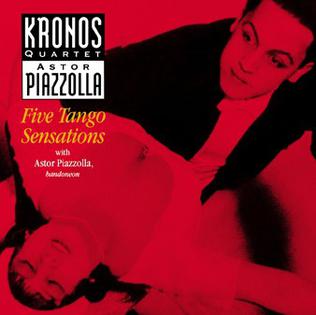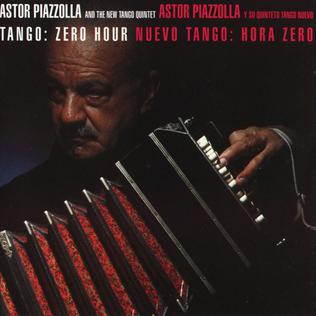
Astor Pantaleón Piazzolla was an Argentine tango composer, bandoneon player, and arranger. His works revolutionized the traditional tango into a new style termed nuevo tango, incorporating elements from jazz and classical music. A virtuoso bandoneonist, he regularly performed his own compositions with a variety of ensembles. In 1992, American music critic Stephen Holden described Piazzolla as "the world's foremost composer of Tango music".

The bandoneon is a type of concertina particularly popular in Argentina and Uruguay. It is a typical instrument in most tango ensembles. As with other members of the concertina family, it is held between the hands, and played by pulling and pushing air through bellows, routing it through sets of tuned metal reeds by pressing the instrument's buttons. Unlike most accordions, bandoneons always employ the same sets of reeds to produce their sound, and do not usually have the register switches common on accordions. Nevertheless, the bandoneon can be played very expressively, using various bellows pressures and other techniques.

The music of Argentina includes a variety of traditional, classical, and popular genres. According to the Harvard Dictionary of Music, Argentina also "has one of the richest art music traditions and perhaps the most active contemporary musical life.

Tango is a style of music in 2
4 or 4
4 time that originated among European and African immigrant populations of Argentina and Uruguay. It is traditionally played on a solo guitar, guitar duo, or an ensemble, known as the orquesta típica, which includes at least two violins, flute, piano, double bass, and at least two bandoneóns. Sometimes guitars and a clarinet join the ensemble. Tango may be purely instrumental or may include a vocalist. Tango music and dance have become popular throughout the world.
Nuevo tango is both a form of music in which new elements are incorporated into traditional tango music, and an evolution of tango dance that began to develop in the 1980s.

Pablo Ziegler is a Grammy Awards winning Argentine composer, pianist, arranger based in New York City. He is an exponent of nuevo tango, and has worked extensively as Ástor Piazzolla's regular pianist from 1978 until Piazzolla's retirement for health reasons in 1989. During their collaboration, they performed with Milva, Placido Domingo, Gary Burton among others. He played with Piazzolla's re-formed Conjunto 9 in 1983 for his Teatro Colón concert with the Buenos Aires Philharmonic. In 1985 Ziegler composed the music for the film Adios Roberto, and in 1990, he established the New Tango Quartet.
Neotango is a distinct genre of tango which goes beyond it both in music and in dance. It is a global movement in which the music includes tracks from all over the world, instrumental and vocal, distinct from the tango in that it includes only modern music recorded in the last 30-40 years, and can be danced using the tango's biomechanics. As a dance form it is still evolving. It is a 'living' globalized tango dance form of the 21st century.
Adiós Nonino is a composition by tango Argentine composer Ástor Piazzolla, written in October 1959 while in New York, in memory of his father, Vicente "Nonino" Piazzolla, a few days after his father's death.
Achilles Liarmakopoulos is a Greek trombonist. He has been a member of the Canadian Brass since 2011.

Libertango is a composition by tango composer and bandoneon player Astor Piazzolla, recorded and published in 1974 in Milan. The title is a portmanteau merging "Libertad" and "tango", symbolizing Piazzolla's break from classical tango to tango nuevo.

Five Tango Sensations is a suite of works (Asleep—Loving—Anxiety—Despertar—Fear) for bandoneón and string quartet written in 1989 by Argentine composer Ástor Piazzolla. It was premiered in New York that year and recorded immediately afterwards by the Kronos Quartet and the composer, who played the bandoneón. The record was one of a set of three internationally tinged albums released simultaneously, the Argentine music of this album being accompanied by the music of South-African composer Kevin Volans on Kevin Volans: Hunting:Gathering and the music of Polish composer Witold Lutosławski on Witold Lutosławski: String Quartet.

Tango: Zero Hour is an album by Ástor Piazzolla and his Quinteto Nuevo Tango. It was released in September 1986 on American Clavé, and re-released on Pangaea Records in 1988.

Antonio Agri was an Argentine violinist, composer and conductor prominent in both the tango and classical music genres.
Pablo Zinger is a conductor, pianist, writer, composer, arranger, lecturer and narrator, specializing in the music of Ástor Piazzolla, tango, Spanish zarzuela, and Latin American vocal and instrumental music.

Anna Maria Mendieta is a professional harpist from the United States. She is best known for pioneering the harp as a contemporary tango instrument. She is the founder, artistic director, and harpist for Tango del Cielo, an award-winning album and international touring show.

The Octeto Buenos Aires was a legendary tango group formed in 1955 by the Argentine bandoneon player Astor Piazzolla. In 1958 the Octeto was disbanded and Piazzolla returned to New York City with his family where he struggled to make a living as a musician and arranger in the next stage of his career that would prove to be so ground-breaking in the history of tango.
Enrique Mario Francini was an Argentine tango orchestra director, composer and violinist who played in various tango ensembles including the Orquesta Francini-Pontier and Ástor Piazzolla's Octeto Buenos Aires.
Histoire du Tango is a composition by tango composer Ástor Piazzolla, originally scored for flute and guitar in 1985 and published in 1986. It is one of the most famous compositions by Piazzolla and is often played with different combinations, including violin or double bass substituted for the flute, and piano, harp or marimba substituted for the guitar.

Summit is an album by Argentinean bandoneonist Astor Piazzolla and jazz saxophonist Gerry Mulligan. The original LP was recorded and released in Italy in 1974.

With These Hands is the third album by the American roots rock musician Alejandro Escovedo, released in 1996. It was his only solo album for Rykodisc.













